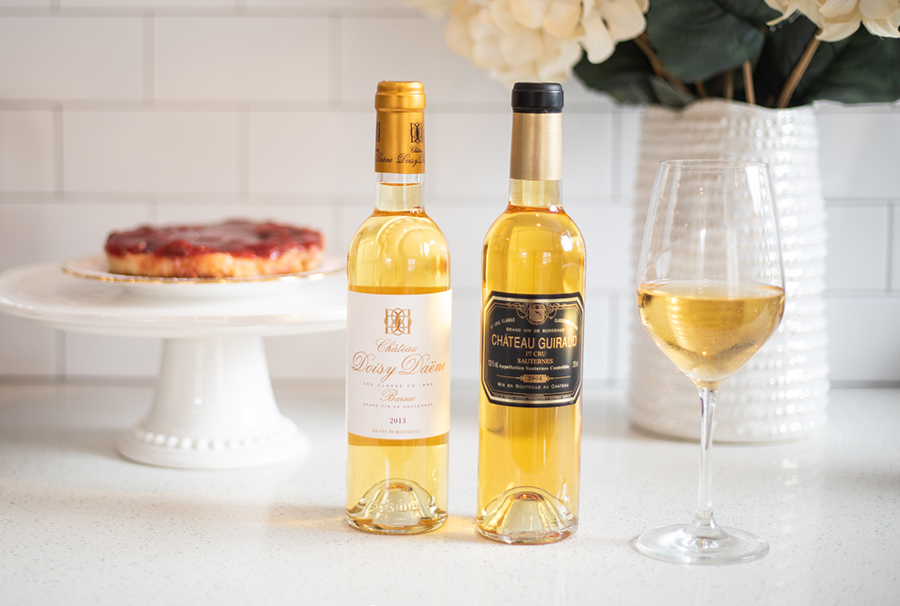For even the most experienced dry wine drinker, sweet wines can prove to be unfamiliar territory. Like their dry counterparts, many grape varieties and blends may be used to produce sweet styles. Within those styles, one can find an entire spectrum of aromas, flavors, textures, and of course, degrees of sweetness. Balance is a desirable quality in any wine, and when the components of a wine (body, alcohol, sugar, fruit, acidity, and tannin) complement one another to create harmony, one can consider such a wine to be well-balanced. Sweet wines have the capacity to be harmonious, express their terroir, and in some instances, evolve in the bottle over many years – just like great dry wines. The following article will explore the most common types of sweet wine.

Sauternes
Pronounced “saw-TURN,” these are the golden-colored, rich, perfumed, and sweet white wines of Bordeaux. Produced primarily from two grapes – Sauvignon Blanc and Semillon – with the occasional inclusion of a third grape called Muscadelle, the finest wines from Sauternes are among the most age-worthy whites in the world. Before harvest, some of the grapes develop a fungus known as Botrytis, also referred to as “Noble Rot,” which focuses and elevates levels of acidity and sugar. Young Sauternes wines are lusciously sweet, with high amounts of alcohol and acidity. They typically display aromas and flavors of stone, tropical, and citrus fruits, along with hints of flowers, honey, and vanilla. Fatty, salty foods like foie gras and blue cheese are a classic match for Sauternes.
Tokaji Aszú
Pronounced “toe-kai-e ah-soo,” these sweet wines from Hungary are also Botrytis-affected, like Sauternes. Tokaji wines are produced primarily from a grape called “Furmint,” usually appear deep amber in color, and come in varying degrees of sweetness. A scale measuring the amount of residual sugar in each wine ranges from three (lowest) to six (highest) Puttonyos. Tokaji Eszencia (Nectar) undergoes a slow and lengthy fermentation, resulting in a wine with very low alcohol, but incredibly high residual sugar and acidity. Their intensely concentrated flavors, longevity, and extreme rarity make these wines highly valued among collectors throughout the world.
Late Harvest
As opposed to grapes harvested at their normal time for the production of dry wines, late harvest grapes are picked later in the growing season, with higher levels of ripeness and sugar. This allows producers to make sweet wines without the influence of Noble Rot. The degree of sweetness found in late harvest wines can vary depending on growing conditions. France’s Alsace region, as well as various areas throughout Germany, are known for late harvest wines, with many produced from white grapes, such as Riesling, Gewurztraminer, Pinot Gris, and Muscat. Alsatian wines labeled “Vendage Tardives” are late harvest, while in Germany, wines labeled “Spätlese” fall into this category. German wines labeled “Auslese” are made from specially selected late harvest grapes which may be botrytized, and are generally sweeter than Spätlese wines.

Eiswein (Ice Wine)
Produced from grapes that are frozen while still on the vine, Eiswein was originally a German Riesling style, though now other cool growing regions emulate the practice. These wines are characterized by their lush fruit flavors, minerality, and bright, nervy acidity. Grapes may be affected by low levels of Botrytis, however, this is not necessary to produce Eiswein. Harvesting must occur at just the right time to avoid losing grapes in extremely cold temperatures. Due to this risk, as well as the small quantity made, Eiswein can command high prices – but the expense is worthwhile to taste such a gloriously sweet wine.
Moscato d’Asti
The Muscat family of grapes is one of the oldest in the world, and while there are many varieties grown today, they all possess a distinct “grapey” quality. Muscat à Petits Grains is used to produce the currently popular, effervescent Moscato d’Asti. Classic aromas and flavors of grapes, stone and citrus fruits, and flowers are found in these wines. They also pair wonderfully with desserts, cheeses, or fresh fruits.
Food Pairing Considerations
Sweet wines can complement a variety of foods that may prove challenging when choosing a wine pairing, including sweet, salty, savory (umami), and spicy (hot) dishes. For desserts, keep in mind that the wine should be as sweet or slightly sweeter than the dish being served. Many sweet wines are also suitable to consume on their own, and in certain instances, may provide you with a truly transcendent drinking experience.
Visit WTSO.com to discover wines from around the world, delivered to your door.



